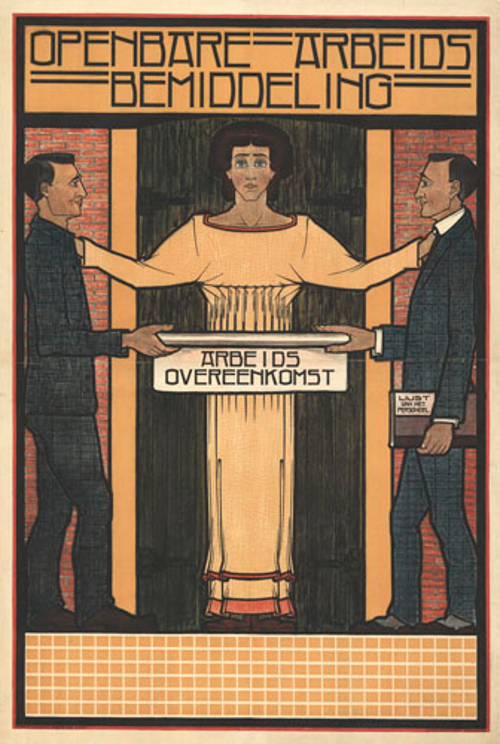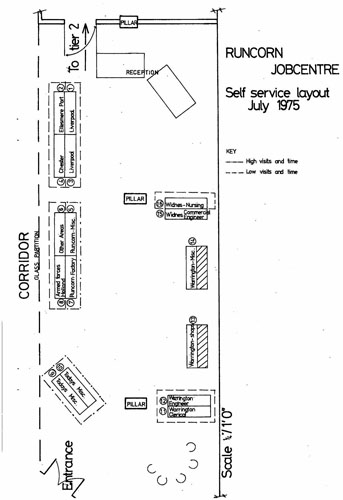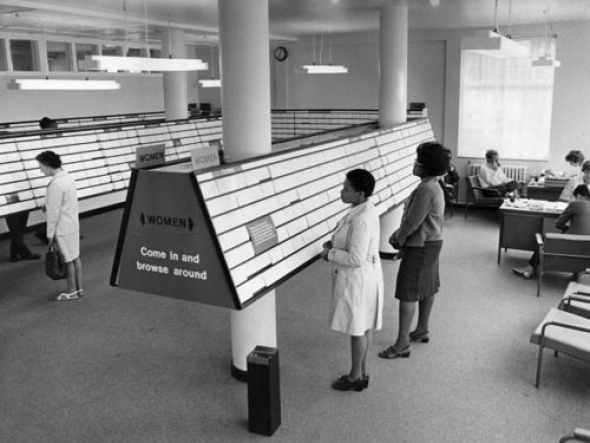A Brief History of The Jobcentre
The Jobcentre has not always existed. A glib statement, yes, but one that is always worth reasserting when discussing such a ubiquitous institution (see 'the state', 'the nation', borders and numerous other seemingly transcendental and timeless, yet decidedly modern, institutions). In fact the Jobcentre, taking into account its predecessors, is little more than one hundred years old. During this time, it has taken multiple forms, performed various functions, been branded, re-branded, hidden, celebrated and vilified. In any case, it has persisted – both as a concrete feature of our high-streets and as an idea of how to organise the economy and society. Many will have had contact with Jobcentres at some point, and more or less everyone will know someone who has. What follows is a critical history of the jobcentre, from its birth up until the present day. Whether you are all-too-familiar with its soft, colourful furnishings or the closest you have got is sat on your sofa watching 'Benefits Street', the aim here is to expose the roots of this institution.
Founding Myths
Copy-catting initial experiments in late-nineteenth-century Germany, the first Labour Exchange was opened in the UK in 1910. The initial idea was deceptively simple: to match the unemployed with employers who had a labour shortage. It was – and is – the simplistic 'common sense' of this founding concept that has given the Jobcentre much of its strength and endurance. As we're often told, in a capitalist economy, the law of supply and demand is absolute – when the state tries to 'plan', things get complicated, inefficient and ultimately fail. Or so the neoliberal line goes. What better state intervention then, than one that does not aim to alter either supply or demand, but rather merely ensures a smoother flow of information between the two. This, in a nutshell, is the central plank on which Jobcentres are built. The solution to market failures is an ever-more-perfect flow of information. In his role as co-founder (along with William Beveridge) of British Labour Exchanges (as they were then called), Winston Churchill neatly summarises this quintessentially liberal-capitalist ideal, declaring that the scheme would remedy 'the lack of mobility of labour and the lack of information about all these questions of unemployment'.1

Image: Poster by Chris Lebau, 'Public employment mediation', Holland, 1928
Fast-forward one hundred years and this central idea – of linking the unemployed to employers, of perfecting the flow of information – can be seen legitimating the Coalition's Universal Jobmatch scheme:
Jobseekers Allowance claimants can now be required to look for work using the government’s new Universal Jobmatch website, or risk losing their benefit. Universal Jobmatch revolutionises the process of looking for work by automatically matching jobseekers to jobs based on their skills and CV. Because the service is operational 24/7 jobseekers' CVs are working for them – even when they’re asleep.2 [italics added]
However, as can be seen here, in practice, Jobcentres have often done more than simply match employers to the unemployed. The statement beautifully illustrates the drive for a constant and seamless flow of labour market information, even when we're asleep. But it also introduces the Jobcentre's other crucial function: the doling out of benefits and the threat of taking them away.
When unemployment insurance (the precursor to the modern benefits system) was introduced in 1911, Jobcentres were the point at which this policy was administrated on the ground. Indeed, by Churchill's own admission, this was not a secondary function. For him, the matching service was directly tied to the administration of benefits: failure to adequately partake in the former would mean disqualification from the latter. In other words, just as in the contemporary Jobcentre, willingness to work is a pre-requisite to receiving benefits. The Jobcentre has therefore acted as a means of constructing, distinguishing and dividing the 'deserving' from the 'undeserving'. Churchill, not mincing his words, justified Labour Exchanges in just such terms: 'I am quite sure that those who know the sort of humiliation to which the genuine working man is subject, by being very often indistinguishable from one of the class of mere loafers and vagrants, will recognise as of great importance any steps which can sharply and irretrievably divide the two classes in our society.'3
On this note, it is worth taking an analytical step back. Because the Jobcentre was not only about matching the unemployed with employers and administrating benefits – it also helped define and quantify the very idea of 'unemployment' and 'the unemployed'. Vagrants, vagabonds, paupers, beggars, bums, drifters, slackers – such characters have always existed. And neither, as we shall see, were Jobcentres the first attempt by a state to intervene in this 'problem'. Rather they can seen as a significant development in the long history of attempts to manage and control the poor, and more widely still, a new means of state intervention in both 'the economy' and 'the population'.
Before the introduction of Labour Exchanges, several unions had experimented with small, trade specific centres in a largely unsuccessful attempt to help their members find work. State provision for the unemployed was peicemeal and infamously punitive. Since before the introduction of the New Poor Laws in 1834, the legislating classes had taken a dim view of the non-working poor. Workhouses, which made the destitute poor perform hard, menial labour for bread and board, were in some sense precursors to Labour Exchanges. They put into practice the idea that the poor who were unable to help themselves deserved to be miserable. But by the advent of the twentieth century these institutions were wearing thin. It was in this context that the contemporary Jobcentre was conceived – somewhere between Victorian moralising and the dictates of contemporary capital. They were a new apparatus for normalising what was often thought of as an unruly, immoral section of the populace, and worse still, a latent revolutionary threat to civil society. They were born out of, and reinforced, the idea of a division between the 'deserving' and the 'undeserving' poor.
This rhetoric, wielded 100 years ago by the founding liberal fathers of Jobcentres, will not be unfamiliar to those living in contemporary Britain. From Channel 4's recent series 'Benefits Street' to the putrid invective of Daily Mail headlines and the Tory party, it is hard to miss this ideological trope. Amidst this divisive language, it is worth reflecting on the physical space itself through which these processes become manifest. The Jobcentre is, after all, an environment, made up of bricks, mortar, brightly coloured soft-furnishings, touch-screens, desks and so on. It is a place people are required to go to regularly – even daily, as the coalition recently announced.4 It is a visible presence on many high-streets. It is, in short, one of the many physical features of the urban environment that structure our lives in significant and under-examined ways. No history of the Jobcentre would be complete without an understanding of how this institution has been designed and constructed architecturally.
Bricks and mortar – place – the changing physical environment
Churchill's fear of Jobcentres becoming 'a permanent club for the unemployed' never became a reality. However, at certain points in time social networks were built up in and through them. In a book of memoirs of unemployed people from the 1930s one casual labourer describes meeting 'a few chaps, unemployed like myself' with whom he 'chummed up'.5 The long winding queues – commonly taking up most of the interior space and often spilling out onto the pavement – were a standard feature of Jobcentres up until the 1970s (and to a lesser extent still today). Such regular and sustained queueing was doubtless conducive to the kind of social encounter described by the casual labourer above. The intention here is neither to mythologise the loss of a vibrant public space, nor to suggest that people don't wait around in Jobcentres any more. It was never thus, and they do. But the architecture of Jobcentres has changed dramatically since their inception, and these changes have more than purely aesthetic implications. In place of a dark, bare waiting room of glazed brick and varnished wood, we are greeted by banners emblazoned with 'the work you want, the help you need', a welcome desk, lime green signage and fluorescent marshmallow sofas. These physical changes both alter the social interactions that take place within jobcentres and reflect the state's shifting attitude to unemployment over the last one hundred years.

Image:Unemployed men at an early Labour Exchange counter, c.1910
In the 1970s, 'employment exchanges' (colloquially referred to as 'unemployment exchanges') began to be replaced en masse by re-branded 'Jobcentres' (a name they have retained to the present day, only with the enigmatic addition of 'Plus'). To say that the design was 'of its time' would be an understatement. The orange and brown colour-scheme, bubble-writing graphics and carpeted interiors are not dissimilar to the set of an Austin Powers film (see 'service board' photo below or, for a hipster bar re-model, why not check out the grotesque new 'Job Centre' bar in Deptford?). Along with this re-branding, the architects and bureaucrats in charge began trying to phase out the counters and queueing spaces that had been the predominant feature of exchanges up until that point. The proposed spatial solution was super-market-style self-service notice boards, which the Employment Service Agency described as 'informal', providing 'the freedom with which they [the unemployed] can browse'. This rearrangement required the unemployed – now referred to as 'jobseekers' – to literally seek employment by physically moving from board to board, within both the structured space of the self-service section and the wider economic structure of the market.
Despite the rhetoric of the greater ‘freedom’ of the system, this spatial change was rather an attempt to redefine the unemployed as active consumers rather than passive recipients of welfare. A fascinating illustration of this is a 1977 study by the Manpower Services Commission on ‘how Jobseekers make use of self service facilities in Merseyside Jobcentres’.6 It is a rigorously researched report, complete with initial aims, research methods used, results, a discussion of these, recommendations, a trial implementation and final conclusions.7 Responding to previous studies of Jobcentre self-service sections by the Manpower Services Commission, its goal was to ‘discover whether the present arrangement of vacancy displays in Self-Service sections in Merseyside allows jobseekers to use the displays effectively’.8 Although it does not indicate how widely its recommendations were implemented beyond the four Jobcentres studied, it nonetheless demonstrates the intent of the state to use the environment of exchanges to shape the unemployed. Before reading beyond the contents page, it becomes clear that the arrangement of the self-service section had a productive purpose.

Image: ‘Jobseeker’ using a self-service display board, c. 1975.9
The study began by charting the movement through the space of 943 jobseekers, and then assessing the success of the spatial arrangements in encouraging jobseekers to search beyond their routine job preferences.10 It discusses specific ways in which free-standing boards can be used to ‘“deflect” the jobseeker further into the display area rather than “bounce” him back out’ (see appendices 1 and 2).11 In making these types of recommendations, the study is orientated and legitimated by broad and sweeping assumptions. The most spectacular of these is the assertive musing that ‘maybe MAN is not a creature of determined curiosity i.e. he will not force his way into the system and may need to be “drawn” into it’.12 What this shows is the powerful structural force which the researchers attributed to the category of space, and their confidence that they could harness this force in the production and regulation of the unemployed. The researchers aimed to produce the unemployed as ‘jobseekers’, encouraging them to become increasingly flexible labourers in terms of their willingness to take a wider variety and geographical dispersion of jobs. For them, this broad goal was embedded in mundane details such as the ordering of display boards – an example being an arrangement ‘to encourage jobseekers to look at the low interest boards as they passed on their way to the high interest boards’.13 As we can reasonably assume that such ‘low interest boards’ displayed lower-paid jobs, this arrangement essentially encouraged downward mobility. It lays bare the jobcentre as an instrument of capitalist production: plugging labour shortages and bringing down unemployment figures regardless of peoples' needs and preferences. It also bares a striking resemblance to the common supermarket policy of placing essentials (e.g. milk) at the back of the shop to encourage customers to buy more. What this report shows, essentially, is how the state materialises ideas in physical spaces, at the very least attempting to mould the behaviour of the unemployed. Thankfully, the exact ways in which this plays out dialectically – between design and use, intentions and contingencies, designers and 'designed' – is less clear cut.
Over the past forty years, the onus to find a job has shifted increasingly, along with the blame for being out of work, onto the unemployed themselves. No longer the victims of a savage and inefficient labour market, jobseekers are now expected to search for work remotely, via the aforementioned Universal Jobmatch scheme. If you have been into a Jobcentre recently, you will know that this is not the place to look for a job, let alone loiter or socialise. When I asked recently if I could get some advice about job-hunting (I was not signed on), the staff at the welcome desk told me “this is not an employment agency, we're more like police”. Alongside the shift to online service provision, policy-makers have phased out not only counters and queueing spaces but also their '90s substitutes – telephone boxes and touch-screen 'Jobpoints'. This, at the same time as long-term jobseekers are being required to sign on everyday. In other words, while services are moved online, daily check-ups are kept face-to-face, rendering the jobcentre an increasingly disciplinary space. Greeted at the entrance by G4S security guards, you are directed immediately onwards by staff at the welcome desk. There is no aimless wandering, no hidden corners to loiter in; innumerable black-blob CCTV cameras hang from the ceiling and there are more than enough staff to keep people moving.
Conclusions
Jobcentres are a monument to work – work as an end in itself, regardless of how menial, regardless of the final aim. This is what workfare schemes are about (that and of course reducing the labour costs of corporate retail giants such as Poundland and Tesco). From Gordon Brown to Iain Duncan Smith, politicians have been attacking 'the unacceptable culture of worklessness' or the 'entrapment' of welfare benefits for more than a decade.14 This blind glorification of work skews our perspective of its use, purpose and social value (or lack thereof, depending on the work). 'John Maynard Keynes predicted that, by century’s end, technology would have advanced sufficiently that countries like Great Britain or the United States would have achieved a 15-hour week. There’s every reason to believe he was right. In technological terms, we are quite capable of this’.15 Given this, what justification can there be for an institution that exists solely to funnel people into carrying out labour with little or no social value? Work should be fulfilling, and where it can't be, it should be – and emphatically can be – reduced to a minimum. Why does the automation of jobs and industries lead to unemployment rather than simply a reduction in working hours (without reducing the wage)?
Because, under capitalism, increases in efficiency (e.g. the introduction of new technologies) translate into either an increase in total output or a reduction of the amount spent on wages. Both of these result in higher profits for shareholders. In a world after capitalism, where social wellbeing and ecological sustainability are society's main goals, increased efficiency would mean maintaining total output and wages, while also reducing working hours. What, then, should we do about Jobcentres? Abolish them outright with immediate effect? Set up daycare nurseries in them? Take Churchill by the letter and turn them into 'a permanent club for the unemployed'? Use them as spaces in which to openly discuss the uses, value and organisation of work? Convert them into public toilets? Clinics? Libraries? Galleries? Kitchens? You get the game – pick a public service, any service. Whatever we decide to do, it should be informed by, not fettered with, a recognition of what Jobcentres have always largely been – disciplinary institutions, capitalist instruments, monuments to work.
Gabriel Bristow gabrielbristow <AT> gmail.com

Image: Before

Image: After
Footnotes
1 Winston Churchill, Parliamentary Debates, House of Commons, 5th Series, 19 May 1909, vol. 5, col. 500 in King, Actively Seeking Work?, p.24.
2 Department for Work & Pensions, 'Jobseekers Required to Use Universal Jobmatch', 04 March 2013, https://www.gov.uk/government/news/jobseekers-required-to-use-universal-jobmatch, accessed on 07/03/13.
3 King p.23
4 http://www.theguardian.com/commentisfree/2014/apr/28/help-to-work-britains-jobless-forced-workfare-unemployed
5 Memoirs of the unemployed, p.226
6 The Employment Service Agency Manpower Service Commission, ‘A study of how Jobseekers make use of self-service facilities in Merseyside Jobcentres, Merseyside ESA Area Report’, 1977, Department of Work and Pensions Archive – ED Publications – STO77R.
7 Ibid.
8 Ibid.
9 Photograph Division of British Information Services, ‘Jobseeker using a self-service section’, N.d. [1975?], Department of Work and Pension Archive – ART.
10 The Employment Service Agency Manpower Service Commission, ‘A study of how Jobseekers make use of self service facilities in Merseyside Jobcentres, Merseyside ESA Area Report’, 1977, DWPA – ED Publications – STO77R.
11 Ibid.
12 Ibid.
13 Ibid.
14 http://www.theguardian.com/politics/2014/jan/22/duncan-smith-benefits-street-shock
http://news.bbc.co.uk/1/hi/uk_politics/7738025.stm
15 David Graeber, 'Bullshit Jobs', http://www.strikemag.org/bullshit-jobs/
Mute Books Orders
For Mute Books distribution contact Anagram Books
contact@anagrambooks.com
For online purchases visit anagrambooks.com







